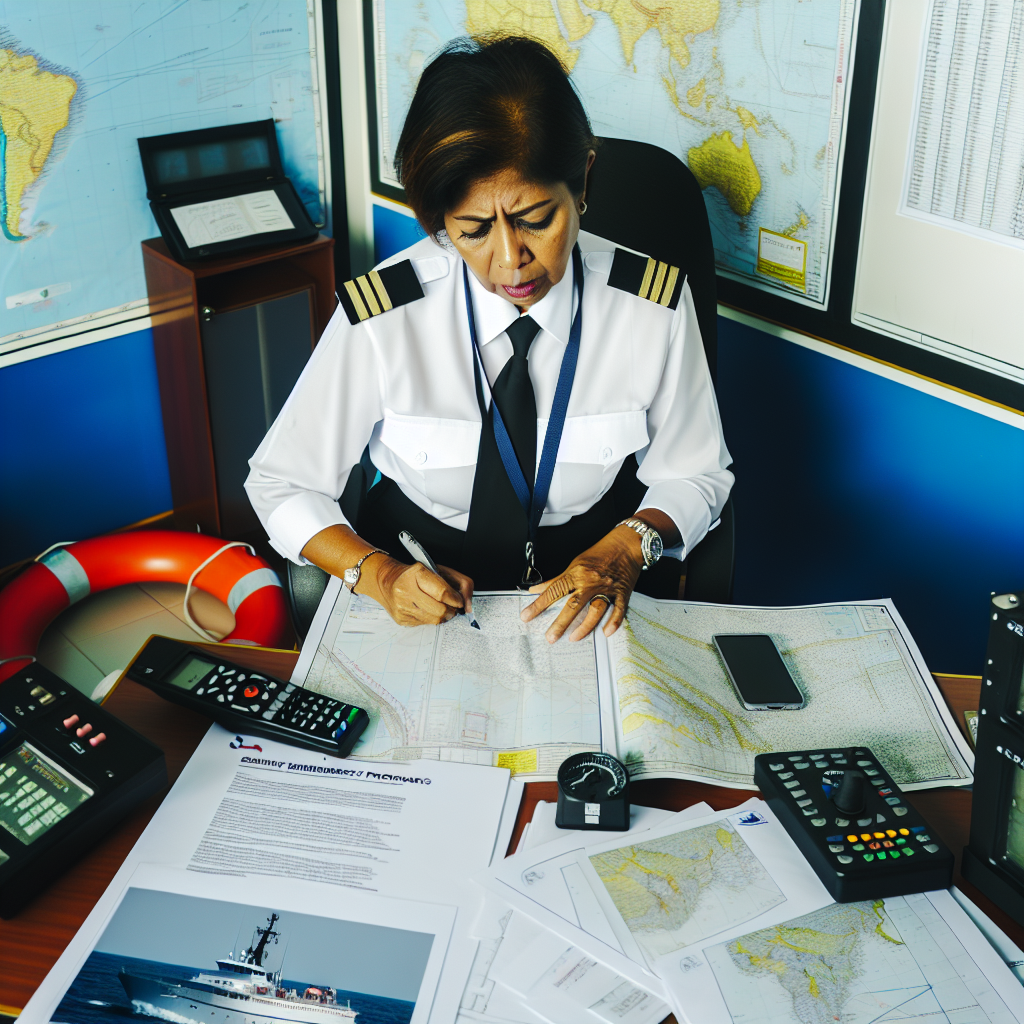Introduction:
Maritime pilots play a crucial role in guiding ships through treacherous waters.
They ensure safe passage for vessels.
Emergency protocols are essential for maritime pilots to safeguard the lives of crew, passengers, and the ship.
Understanding weather conditions:
Weather plays a crucial role in maritime operations.
Pilots must be aware of:
- Importance of monitoring weather patterns and forecasts
- To ensure the safety of the vessel and crew, it is essential to keep track of changing weather conditions through reliable sources such as the National Weather Service or local meteorological agencies.
- Knowing how weather can impact ship navigation and safety
- Weather can pose significant challenges for maritime pilots, from strong winds and rough seas to fog and thunderstorms. Understanding these impacts is vital for safe navigation.
- Taking necessary precautions and adjustments based on weather conditions
- Maritime pilots must be prepared to make adjustments to their navigation plans based on current weather conditions. This may include altering course, reducing speed, or seeking shelter in a safe harbor.
Being well-informed about weather conditions is essential for maritime pilots to ensure the safety of the vessel, crew, and cargo.
By staying vigilant and proactive in monitoring weather patterns and making necessary adjustments, pilots can navigate challenging conditions with confidence.
Communication protocols:
Effective communication is crucial in any maritime operation, especially during emergencies.
Maritime pilots should establish clear communication channels between themselves, the crew onboard, and port authorities to ensure that information flows smoothly and accurately.
During emergencies, such as engine failure, severe weather conditions, or collision threats, standardized communication procedures must be followed to ensure quick and effective responses.
This includes using predetermined codes or signals to convey critical information swiftly and accurately.
It is essential for all personnel involved in maritime operations to be trained in emergency communication protocols.
This training should cover the use of emergency communication equipment, such as radios and distress signals, as well as the specific procedures to be followed in different emergency scenarios.
By ensuring that everyone is well-versed in emergency communication protocols, maritime pilots can minimize the risk of miscommunication or delays in response.
Ultimately, this leads to better outcomes during challenging situations at sea.
- Establishing clear communication channels between pilot, crew, and port authorities.
- Using standardized communication procedures in case of emergencies.
- Ensuring all personnel are trained in emergency communication protocols.
Learn More: Interview Tips for Aspiring Transportation Security Screeners
Techniques for Avoiding Collisions and Grounding
One of the most critical aspects of piloting a ship is the ability to avoid collisions with other vessels and grounding on reefs or sandbars.
To prevent collisions, pilots must constantly monitor the ship’s position relative to other vessels.
They also use radar and AIS systems to identify potential risks.
Communication is essential with other vessels.
Transform Your Career Today
Unlock a personalized career strategy that drives real results. Get tailored advice and a roadmap designed just for you.
Start NowIn the event of a potential collision, pilots should be prepared to change course, slow down, or stop the vessel if necessary.
Grounding can be avoided by staying within designated shipping lanes.
Following navigational markers is critical, as is using depth soundings.
Pilots must ensure the vessel has enough water beneath its hull.
Maneuvering the Ship in Tight Spaces or Rough Waters
Maneuvering a ship in tight spaces or rough waters requires skill and precision.
Pilots must be able to use the ship’s propulsion systems, rudder, and thrusters effectively.
Navigating through narrow channels and berthing areas is challenging.
In congested ports, pilots must be especially careful.
In rough waters, anticipating the effects of wind, waves, and currents is crucial.
These factors influence the ship’s handling characteristics.
Adjusting maneuvers accordingly is vital.
It is essential to maintain control of the vessel at all times.
Pilots must be prepared to react quickly to changes in the environment.
Understanding Emergency Anchoring Procedures
In certain emergency situations, such as engine failure or loss of steering, pilots may need to anchor the vessel quickly.
This action helps to prevent drifting or grounding.
Understanding emergency anchoring procedures is crucial for ensuring safety.
Pilots must determine the appropriate anchoring position effectively.
Deploying the anchor correctly is vital.
Monitoring the vessel’s position ensures it remains secure.
Showcase Your Business Today
Reach thousands of readers actively exploring professional services. Publish your business profile and grow your audience now.
Publish NowAwareness of obstacles or hazards on the seabed is important.
Such hazards can impact the anchor’s holding power.
Mastering these techniques enables maritime pilots to respond effectively to unexpected challenges.
This training helps safeguard the vessel, its cargo, and the lives on board.
Find Out More: The Impact of Globalization on Logistics Consulting
Fire Safety Protocols
Being prepared for potential fire hazards on board is crucial for maritime pilots to ensure the safety of the crew and vessel.
Identifying Potential Fire Hazards
- Regularly inspect all areas of the ship for possible fire risks such as faulty wiring, flammable materials, or overheated machinery.
- Educate all crew members on the importance of fire safety and encourage them to report any potential hazards immediately.
- Maintain a detailed inventory of all flammable substances on board and ensure they are stored in designated safe areas.
Conducting Regular Fire Drills and Safety Inspections
- Organize frequent fire drills to test the crew’s response time and effectiveness in handling fire emergencies.
- Assign specific roles and responsibilities to crew members during fire drills to ensure a coordinated and efficient response.
- Review and update fire safety protocols regularly based on the findings of safety inspections and drills.
Knowing How to Effectively Contain and Extinguish Fires
- Equip the ship with the appropriate fire extinguishers, fire blankets, and other firefighting equipment as recommended by maritime safety regulations.
- Train all crew members on the proper operation of firefighting equipment and techniques for containing and extinguishing different types of fires.
- Establish communication protocols for alerting nearby vessels, ports, and maritime authorities in case of a fire emergency.
By implementing these fire safety protocols and continuously training the crew, maritime pilots can minimize the risk of fire-related incidents and ensure the safety of everyone on board.
See Related Content: Navigating Routes: Tips for Efficient Courier Deliveries
Medical emergencies:
Medical emergencies can happen at any time while out at sea.
Maritime pilots need to be prepared to handle them effectively.
Here are some key protocols every maritime pilot should know when it comes to medical emergencies:
- Training crew in basic first aid and emergency response
- Establishing emergency medical kits and supplies on board
- Knowing how to communicate with onshore medical services for assistance
It is essential that all crew members receive training in basic first aid and emergency response procedures.
This training should include CPR, wound care, and how to handle common medical emergencies that may arise while at sea.
Every vessel should be equipped with emergency medical kits that are stocked with essential supplies such as bandages, antiseptic wipes, pain relief medication, and other medical necessities.
These kits should be easily accessible in case of an emergency.
In the event of a serious medical emergency that requires advanced medical care, maritime pilots should know how to communicate with onshore medical services for assistance.
This may involve using a satellite phone or radio to contact medical professionals who can provide guidance on how to handle the situation until help arrives.
By following these protocols and being prepared for medical emergencies, maritime pilots can ensure the safety and well-being of their crew members and passengers while out at sea.
Explore Further: Networking Tips for Transportation Security Screeners

Man Overboard Protocols
Implementing man overboard drills and training: Maritime pilots should regularly conduct man overboard drills to ensure all crew members know their roles and responsibilities in such an emergency situation.
Training should cover the proper use of equipment and communication protocols.
Utilizing life-saving equipment such as MOB buoys and life rafts: Having the appropriate equipment on board is essential in a man overboard situation.
MOB buoys can be thrown overboard for the person to grab onto, while life rafts can be deployed for a more extended rescue operation.
Establishing clear procedures for locating and rescuing a person overboard: It is crucial to have a structured plan in place for quickly locating and rescuing a person who has fallen overboard.
This plan should include designated lookouts, communication channels, and coordinated efforts between crew members.
Man overboard incidents can happen unexpectedly and require swift action to ensure the safety of the individual in distress.
By implementing these protocols and procedures, maritime pilots can be better prepared to handle such emergencies effectively and efficiently.
Emergency response plans for different scenarios:
- Developing contingency plans for various emergencies such as engine failure, loss of steering, or grounding.
- Assigning specific roles and responsibilities to crew members in emergency situations.
- Conducting regular emergency drills to test the effectiveness of response plans.
In the unpredictable world of maritime piloting, emergency situations can arise at any moment.
It is crucial for maritime pilots to have detailed response plans in place to effectively handle these scenarios and ensure the safety of the crew, passengers, and vessel.
Developing contingency plans for various emergencies:
In the event of an emergency such as engine failure, loss of steering, or grounding, maritime pilots must have a clear plan of action.
This plan should outline step-by-step procedures to address each specific scenario, taking into account factors such as weather conditions, proximity to other vessels, and the availability of rescue resources.
Assigning specific roles and responsibilities to crew members:
During an emergency, clear communication and coordination are essential for a successful response.
Maritime pilots should assign specific roles and responsibilities to each crew member to ensure that everyone knows what is expected of them in the event of an emergency.
This may include designating a person to communicate with authorities, coordinate evacuation procedures, or secure necessary equipment.
Conducting regular emergency drills to test the effectiveness of response plans:
Practice makes perfect, and this holds especially true in emergency situations.
Maritime pilots should conduct regular emergency drills to test the effectiveness of their response plans and identify any areas that may need improvement.
These drills should be conducted in a realistic setting, with crew members responding as they would in a real emergency.
By simulating different scenarios, pilots can better prepare themselves and their crew for any situation that may arise at sea.
Emergency Protocols for Maritime Pilots
Emergency protocols are crucial for maritime pilots to handle unforeseen situations at sea.
Continuous training and preparedness are vital to ensure safety.
Showcase Your Business Today
Reach thousands of readers actively exploring professional services. Publish your business profile and grow your audience now.
Publish NowAdditional Resources
What You Need To Know About The Transport Of Dangerous … – IATA
[E-Books for Sale]
The Big Book of 500 High-Paying Jobs in America: Unlock Your Earning Potential
$19.99 • 500 High-Paying Jobs • 330 pages
Explore 500 high-paying jobs in America and learn how to boost your career, earn more, and achieve success!
See All 500 High-Paying Jobs of this E-Book
1001 Professions Without a Degree: High-Paying American Jobs You Can Start Now
$19.99 • 1001 Professions Without a Degree • 174 pages
Discover 1001 high-paying jobs without a degree! Unlock career tips, skills, and success strategies for just $19.99!




